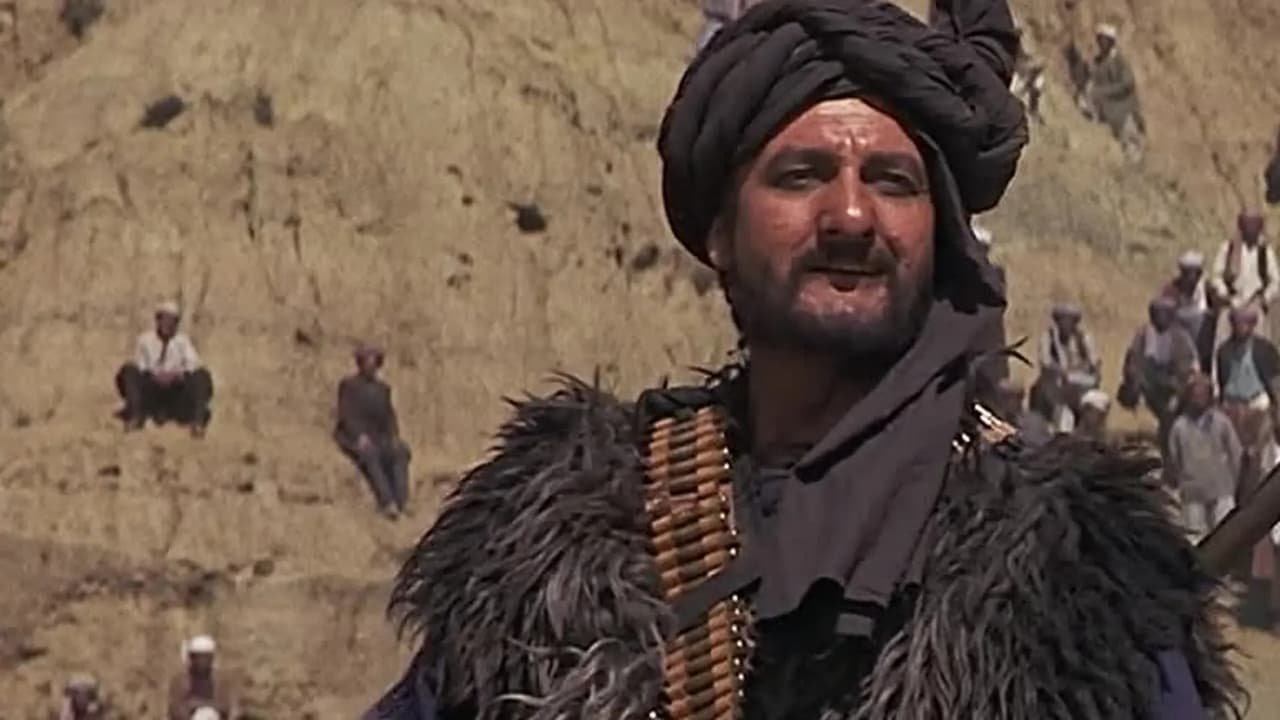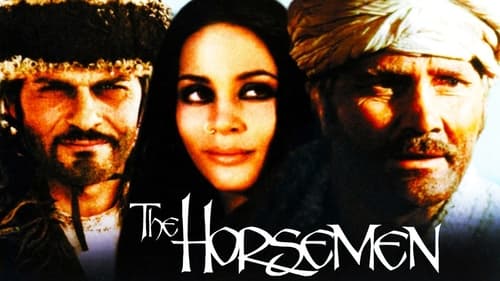


Good concept, poorly executed.
... View MoreAm i the only one who thinks........Average?
... View MoreA lot of fun.
... View MoreIt really made me laugh, but for some moments I was tearing up because I could relate so much.
... View MoreThis movie, which I saw for the first time in 1971, changed my life forever. From the first moments of the film, I was struck by the stunning Afghan scenery. Over the next three years, I visited Afghanistan three times. It was a fantastic adventure, like a voyage in another time, on another planet. Since then, I have not stopped traveling in this part of the World.The film is based on Joseph Kessel's novel, "Les Cavaliers," written following his travel throughout Afghanistan in the early 60's. Kessel is, in the tradition of Saint-Exupery, Malraux, Pierre Mac Orlan, and Hemingway, an adventurer, journalist, globetrotter, and great writer, a man who tried to make the novel "the privileged expression of the experienced adventure." The action takes place on the vast plains around Maimana in the northwest of the country, across the Hindu Kush, and in Kabul. The drama revolves around the "mad horse," Jahil, with its almost human presence. Uraz, son of the great "chapendaz" Tursen is to ride Jahil, Tursen's latest prized white stallion, in the great "buzkashi" of the King, in Kabul.The Afghan national game of "buzkashi" dates back to the time of Ghengis Khan. In this fierce competition, played on the northern steppes by expert horsemen, everything goes. Hundreds of "chapendaz" horsemen independently compete to grab and carry the carcass of a goat or a small calf to the circle of justice, outlined on the field.If Uraz wins, Jahil is his to keep. How can he not win? "If you cannot win on Jahil, you cannot win on any horse," says Tursen. Uraz, like his father before him, is now the most famous "chapendaz" in the "three (northern) provinces." Nevertheless, his quest for glory seems endless, as an inner demon keeps driving him to surpass both his father and himself. An old lady in the bazaar says of him, "If you wager him for glory, you will lose. If for money, you will win." At the "buzkashi" in Kabul, Uraz will know defeat. He not only loses the game, but his leg is fractured. His life lesson about pain and hate begins as he returns to Maimana, vanquished, prouder, more resolute, and crazier than ever.Uraz has the choice of two roads to return to Maimana: the relatively easy road across the terrible Hindu Kush Range, through the Salang Pass, the World's highest pass at 10,000 feet, or the dreadful "old road," running through the Unai and Hajikak passes, both also near 10,000 feet, Bamiyan, followed by more high passes, before finally arriving on the northern steppes. Of course, Uraz chooses the "old road," challenging himself to the limit, in order to redeem himself in his own eyes, and also those of his father. For all his toughness, his father had never traveled that road.As if the "old road" was not challenge enough, Uraz, whose fractured leg is fast becoming gangrenous, tempts his "sais" (groom), Mokkhi, with a pact that involves ownership of the magnificent Jahil.On the road, Mokkhi, meets with love in the arms of the beautiful "untouchable," Zareh, but also experiences greed, a taste for murder, and a pitiful downfall. Zareh, as beautiful as she is devious, inspires Mokkhi to murder and destruction. She is herself tormented by "the horse": "Do you know, great Prince, what brought me to you that first night?...it was the horse." Along this endless "old road," the trio each confronts the worst in themselves, and arrive at their destination perverted and lost. There is also the mysterious and likable character, Hayatal with whom Uraz will eventually continue wandering the steppes.The movie, filmed for six months in Afghanistan, and then in Spain, in 1969-1970, was directed by John Frankenheimer. Screenwriter Dalton Trumbo recognized there was no need to embellish Kessel's fantastic adventure, and faithfully followed the book's story line.The stunning cinematography is the result of the collaboration of the distinguished French cinematographer Claude Renoir (of the artistic lineage,) Andre Domage, and James Wong Howe. They give an accurate taste of the beauty of the rugged Afghan country and of its people. In particular, the remarkable sequences of the buzkashi of the King, in Kabul, and the flashback of Tursen's buzkashi, through the great open steppes of the north, are worth the admission by themselves. There are also actual scenes of organized fights between camels, rams, and partridges (the Afghans are big gamblers).The casting of westerners as principles may seem strange at first, until one remembers that there were neither TV nor movies in Afghanistan, in 1970, and therefore no Afghan actors. Frankenheimer wanted Yves Montand or James Garner for the lead, but learning that he was an expert rider, chose Omar Sarif instead. The buzkashi scenes required 25 days of shooting. Of course, Sharif had to appear in some of these scenes, but the chapandaz, impressed by his superior riding, unobtrusively "chaperoned" him through the most dangerous moments. Omar Sharif gives one of his best, if not the best, performances ever. On the other hand, Jack Palance was not skillful enough to ride in the mayhem of the game, and required an Afghan rider stand-in for these sequences. However, with his both feet on the ground, Palance's presence on the screen is overwhelming. As I traveled through the northern provinces of the country, I must have met two or three Palances, and as many Sharifs. By some extraordinary coincidence, Leigh Taylor-Young also bears a strong resemblance to the now famous "Afghan girl," who appeared on the front cover of the National Geographic Magazine, in 1984.The renowned French composer Georges Delerue wrote the music, remarkable in its lyricism and romanticism, which integrates itself perfectly in the film."The Horsemen" is a stunning film, inspired by epic adventure and timeless conflicts which, given the present condition in Afghanistan, I am afraid can only now be experienced in an armchair.
... View MoreOmar Sharif and Jack Palance may be the only names in this cast that most will recognize but the story based on an Afghan tale, set in Afghanistan before the Russian invasion, is a classic tale which lays out a great deal of Afghan culture during the period before the great disruption by the West. Afghanistan returned to the public eye after the post-911 invasion to depose the Taliban but the state of knowledge about these marvelous independent people who fought the British Empire to a standstill, still remains obscure. The game of buzgashi, a kind of polo for Weidman, was the core for many of the tribesmen. Its importance as an institution marking the status of tribes and individuals has no real counterpart in Western culture, and this is a tale of intrigue and self-learning, framed in a cultural setting we still have yet to understand.
... View MoreThere is so much of interest in this compelling film, set in Afghanistan. Based on the book by Joseph Kessells, a writer of rare insight.Centered around the ancient game of Buzkashi, played on horseback, and only in the three northern provinces of Mazar-i-Sharif, Maimana and Kataghan. [The game had it's origin in a training routine instituted by Ghengiz Khan, which both conditioned his men for warfare and provided a means of feeding his army. A very large circle was formed by his warriors and as the circle closed no animal was permitted to escape.]There are some terrific scenes of the first "Royal Buzkashi" played on Bagrami Plain, just outside Kabul, which had been decreed by the king. Also some great footage of the country, depicting the beautiful and varied terrain encountered as Uroz makes the self-imposed and dangerous journey back to his home province in the North.The interplay of all the characters is an education in understanding the powerful role human emotion and upbringing play in all our lives, as both Tursen(the father) and Uroz(the son) attempt to come to terms with their own harsh anger and pride. The consequences spill over and embroil other individuals in the story. The story also gives some insight into the different way of thinking engendered by the cultural mix of religion,relatively isolated living, and living in a harsh environment where survival can be pretty raw.Contrast is drawn by the mix of ancient and modern. One such scene has Tursen (Jack Palance),who as Head of Osman Bey's stable is addressing the chopendoz,(players of Buzkashi), pauses to look upwards at a jetliner passing overhead whilst he stands on "The Roof of the World". Another takes place in the modern hospital in Kabul.Both Palance & Sharif give of their finest, very well supported by a great character cast.A dramatic part of the story unfolds in the Bamian Valley, where Uroz gambles & loses the very thing he later realise he loves and wants back. Historically this part of the film contains important footage of the giant Budhas that were carved into the cliffside, until deliberately destroyed by Talliban militia.All in all, an excellent and enjoyable film and I am surprised it has not been shown on Television or re-issued on disc, as the world focussed on that area just a short time ago.
... View MoreNot having seen this film since its initial release, I have vague moments of recollection (I was eleven at the time) but, after all these years, I still remember this film, a few scenes-even the theater where I saw it-so that has to count for something. We, my parents, and myself went to many, many movies so it was not unusual for me to come along, even at decidedly adult fair such as this. My mother had a crush on Omar-notwithstanding that they share the same passion for bridge. Frankenheimer had a good reputation for producing and directing interesting, offbeat films that hit as often as they miss-The Manchurian Candidate, Grand Prix, and Black Sunday come to mind. So, we gave this film a shot.While I do not remember the plotline to any great extent, what I do remember quite vividly was that this film took place in Afghanistan, and features quite prominently the national sport of Buzkashi-a sport whereby riders on horses attempt to deposit the carcass of a lamb in a circle. Also, this has what is quite honestly the best performance in a film by Omar Sharif you will ever find. He plays a great rider who is injured early in the film. He broads about a lot but finally finds redemption by returning to the sport that nearly killed him for that one last ride. I do not remember if he makes it through alive.Buzkashi is an old, old brutal sport/ritual full of tradition and ceremony. The film took great pains to present this dying spectacle as realistically as possible and is the great set piece to the film. A true Man's man sport, it is not for the fainthearted. For me, at eleven, I was not used to cinematic `realism' even though by then I had seen hundreds of films. Perhaps it is why I remember it so for it made quite an impression.The film was transferred to video but is long out of print and only available through collectors. It has not made it to DVD, unfortunately. I have not seen it since it initial release.Still, in a long career for Frankenheimer, this is a film that should not be forgotten and is probably one of his best.
... View More